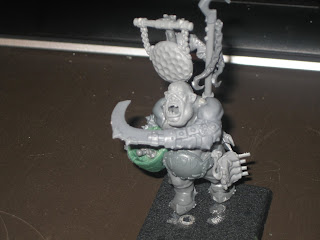So, its been quite a while since i updated this blog. In the next few months I will be kicking off a Mordheim campaign, and that got me motivated to do some serious terrain building. While I didn't successfully pull off any "in-process" shots to show how it was done, I've got the following images to detail my effort thus far. For scale, all these buildings but the dockyards are on 12x12in sheets of MDF.
The first is a stonemason's house. Just a basic house with a few docorative bits. Includes a second floor deck and destroyed walls for placing/hiding models.

The second is the most complete of the buildings, one I've come to call "Bill the butcher's". Complete with stable area for animals, butcher's block in the front yard, and hanging dead cow (thanks GW giant kit).

The next up is the 50% complete first-half of the mordheim dockyards. I see it eventually spanning 2 1x2ft seconds so it could form an entire board edge. The basic structure is done, but needs "mordheimizing" as I call it, adding broken beams, beams and creates floating in the water, and lots of crates along the docks. I haven't decided yet whether one of the dock sections will actually have a ship at it to provide even more high places and cover.

Fourth is the old-mill. The basic structure is completed. It still needs a roof. Also, as its a solid structure, I'm planning to add stairs/platforms/walkways around the outside of it to provide places for models to go, as well as some fallen/pilled logs on the base.

Next is the Dwarf Forge, about 60% complete. The walls still need to be constructed, the chimney finished, and something constructed in the fenced in area. I'm seeing myself using some bitz from the dwarf anvil of doom set.

Last but not least is the clocktower. Its not your eyes, the structure is leaning somewhat, and in true GW/Empire fashing is held up with supports and chains. This has completed rickety ramps and platforms around it for models to climb/snipe from. Not sure what else to decorate around the base. A detail to notice are the clock hands are two-feiry comets, forming a twin-tailed comet during most times of the day.


That is all for now. Updates coming when new things are completed. Most of the future new buildings will be town squares and ruined standard buildings.
































